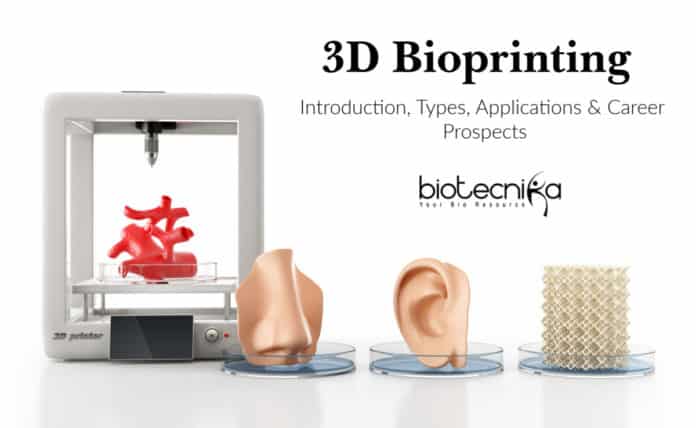3D Bioprinting Career Prospects, Types & Applications
If it is your domain of interest and you are blessed to have technical brains you can make yourself step into an exhilarating and proliferating career of 3D printing.
Have you ever thought of printing the house you live in? Or getting prints of Food you want to eat or those shoes you want to wear? That really seems like science fiction but 3-D printing is considered to be capable of accomplishing these visualizations. Loads of research has already been done in the field of 3D Bioprinting with organs like 3D Printed Pancreas, 3D Printed Mini-Brains, 3D printed Skull, 3D printed Skin Grafts and much more. In this artcile, we will try to understand what is 3D Bioprinting, types of 3D bioprinting, 3D Bioprinting Career Prospects, Companies involved in 3D Bioprinting and much more.
What is 3D Bioprinting?
This is an art of making three-dimensional solid objects from a digital file. It is a technology having roots in 3D imaging and layer by layer additive fabrication. This involves scanning of the digital model into slices using computer-aided manufacturing technology followed by constructing 3D geometry by layer-by-layer printing. This is emerging as a novel
blooming technology which might have an acute impact on human lives.Rapid prototyping may be used as a synonym for 3D printing technology. It was invented back in the year 1980. It is extending its arms over education, manufacturing, engineering, and most importantly medicine. Making prosthetics, possible tissues and organ models are some of its benefits.
Applications of 3D Bioprinting?
3D bioprinting, a wider applied multidisciplinary field of 3D printing technology in life science comprises of advanced biomedical applications like constructing human permanent implants, drug testing model, controlled drug releasing and biomimetic scaffolds. 3D bioprinting uses layer by layer method to pledge materials known as bioinks which are substances made of living cells and resemble an extracellular matrix environment. Bio inks are utilized for creating complex tissue models with application in medical and tissue engineering fields.
The building of 3D models of tissues and organs by applying 3D bioprinting has been made possible. This innovative technology involves biological materials, growth factors, and cells. Cell biologists and tissue engineers really believe that 3 D bioprinting can alter the way we respond to aging and it can further change the way we treat diseases.
3D bioprinting can contribute to reducing the time and cost to introduce the new drug in the market. During new drug development, 2D cell cultures are not efficient in predicting the toxicity of drug which can be done competently in 3D models cutting the need for pre-clinical trial stages.
How 3D Bioprinting is going to contribute: a glimpse!
- Various Types of 3D Bioprinting
In 3D bioprinting, digital design for a 3 D structure is fabricated using layer by layer technique. It includes Initializing from digital design for a living tissue, designing layer by layer in a fashion followed by using living cells eventually mixing with biocompatible scaffolds to build viable tissue.
Bioprinting technique utilizes computer-aided design software to build 3D models of tissues and organs, diffuses the data to the control center. Position and speed of printing nozzles in bioprinters for precisely depositing cells and materials is also controlled precisely.
Skin bioprinting: the imminent solution to burn wound reconstruction?
Layer by layer 3D bioprinting has been used to construct artificial skin which is needed when it comes to curing skin diseases, testing the cosmetics or more severely to treat burns. Extensive burn injuries which require surgical excision of bruised skin and replacing it with conventional skin substitutes, this method can be switched to using 3D bioprinting by depositing of cells along with scaffolding materials over the injured parts.
Functional skin models have been constructed using inkjet printing. Firstly, Dermal/epidermal like scaffold with keratinocytes and fibroblasts were constructed which on the culture at the air-liquid interface (ALI) gave rise to the appearance of dermal and epidermal layers. Between the two layers were printed melanocytes to complete the biomimetic skin. Researchers are still trying to print skin appendages like sweat glands, melanocytes, endothelial cells, hair follicles and sebaceous glands in the skin. Preparing artificial skin by using this approach followed by targeting can definitely offer possibilities of effective wound healing.
However, skin bioprinting whether in vivo or in vitro faces various clinical and regulatory challenges which need to be tackled before it enables exact placement of cell types. Despite the initial application of bio-printed skin in cosmetic, pharmaceutical and chemical testing applications, the long term vision of the researchers is to translate 3D bio-printed skin into clinical use.
Cartilage Bioprinting – An approach to boost regeneration!
If a patient suffering from cartilage lesions is asked, he could only explain how life quality is compromised, the reason being cartilage lesions fail to heal naturally. Cartilage is an elastic connective tissue supporting and protecting the human body. Since it is unable to repair by itself, if damaged, needs to be replaced by substitutes. 3D bioprinting holds the advantages to mimic natural cartilage over conventional techniques thus showing huge application prospects in the cartilage tissue repair. There are many references which exhibit cartilage tissue regeneration by various researchers. The use of chondrocyte-loaded scaffolds, mesenchymal stem cells (MSCs), bone marrow cells are being used to prepare bio-inks for constructing cartilaginous tissue. Although bioprinting in cartilages faces challenges like cartilage having weak mechanical properties, others being a steadiness of the implanted cartilage tissues in the joints and finally their amalgamation to surrounding host tissues. The use of chondrocyte-loaded scaffolds, mesenchymal stem cells (MSCs), bone marrow cells are being used to prepare bio-inks for constructing cartilaginous tissue.
Can Tumor Cells Bioprinting be used to cure cancer?
Nevertheless, it will be revolutionary making bioprinting part of the future of cancer treatment. 3D printing can provide direction to replacing enduring painful radiation or chemotherapies. One could expect printing tumor cells, analyzing the impacts of various anticancer drugs on it. In this way, 3D bioprinting illuminates the precise composition of complex tumor cells. Bio printed tumor models could reiterate the different stages of the in vivo tumor advancement to carry out the basic biological studies. Drug screening can be imagined to reach higher levels ending in achieving personalized anticancer therapies.
3D Bioprinting Career Prospects – What it can offer as a career?
Development in 3D printing technology can give rise to broad potentials for employment opportunities. 3D printing could prove helpful in forensic sciences where one can reconstruct bones and body parts or ambiguous evidence assimilated from crime scene investigations. 3D printing has applications in paleontology: in reconstructing the fossils, in archaeology: replicating the historical artifacts, in aerospace for astronauts: to create space food and undoubtedly in healthcare and biopharma.
-Biomedical technology – One can plunge into biomedical research implementing 3D bioprinting to develop new solutions to medical ailments.
-Academics – Stepping into academics will always persist as a good option as now a day many organizations are introducing hands-on techniques in 3D bioprinting to students. Well skilled instructors will remain in demand in the future to provide training for company crash courses, at universities and technical schools
-Biopharma Companies – A large number of pharmaceutical and allied industries would be trailing for candidates skilled in designing, modeling, and engineering with science backgrounds. The contribution of 3D printing in healthcare is expected to grow significantly over the next decade. In developing countries like India, the technology is still in the growing phase but it may change the future of healthcare industry soon. Over 15% of 3D printing companies comprise of medical 3 D bioprinting.
Few companies in various countries have been enlisted here which are majorly affianced in medical 3D Bioprinting:
- Celllink – It’s the first bioink company in the world. It is into designing and developing bioprinting technologies that enable researchers to 3D print organs and tissue.
- Organovo – An Organization headquartered in San Diego, California. They are proposing liver tissue generated by 3D bioprinting for R&D.
- Aspect Biosystems – A Canadian company commercializing bio-printed “living human tissues“. They aim to strategically partner with life science companies, as well as academic researchers, to develop a portfolio of 3D Bioprinted human tissues.
- Regenovo Biotechnology – A Chinese company offering its bioprinter “Regenovo” for constructing organs and tissues. It provides professional integrated solutions in 3D printing technology for biomedical applications.
- TeVido Biodevices – A US-based company working on bio-printed breast tissue.
Many other companies worldwide like Rainbow Biosciences , RegenHU, Bio 3D technologies , GESiM, Osteopore International , nSCrypt Inc., Advanced solutions Life sciences , Micro Fab Technologies Inc., Digi Lab Inc. , Next 21, Rokit , Stratasys , Med Prin and Form Labs are working to make 3 D bioprinting revolutionize the medical and health care sector .
Scope in India – In India with the government offering grants to bring 3D bioprinting into the right frame many small organizations have turned up to contribute in this sector e.g. NBIL, situated in Bengaluru, Karnataka has developed ‘Trivima’ – India’s first 3D bioprinter to cater the necessities of researchers working in 3D bioprinting domain.
If you are willing to choose 3D bioprinting as a career option you‘ll need to grasp knowledge with 3D CAD (computer-aided design) to construct 3D objects. You need to have a clear understanding of how 3 D bioprinters can be put into process besides staying acquainted with latest technical breakthroughs and demand for customized prosthetics.
Education / Degree required – No particular academic credentials are required to establish a career in 3D bioprinting. People with life science background are considered to handle bioprinters however engineering degree in biotechnology or related subjects is admirable.
Creating Bioprinters may provide exceptional abilities to humans to engineer the human body by creating artificial organs and tissues. With immense impact, this technology has gained a lot of acknowledgment in the past short span of time. Confronting aging factors, illuminating the new ways to fight deadly diseases or injuries are down the line for 3D bioprinting.
To bridge the gaps between organ demand and availability, 3D bioprinting can give a leapfrog jump by making bioengineered organs available. Although 3D bioprinting is going through infancy phase in India, the fact, it is a very transformative technology cannot be overlooked either. It can lead to gigantic shifts in patient outcomes.
So, if you are captivated with advanced technologies and possess an eye for precision then embrace the expanding world of 3D bioprinting as your expertise.
 is an ]experienced faculty at BioTecNika with a keen interest in keeping herself motivated to learn new and more. The above article on 3D Bioprinting is one such example of her deep knowledge of trending innovations in life science & medical field. She has expertise in Biotechnology and Microbiology and completed her Ph.D. in Biotechnology. Dr. Nidhi has also been awarded at several workshops and conferences and has publications in reputed international journals.
is an ]experienced faculty at BioTecNika with a keen interest in keeping herself motivated to learn new and more. The above article on 3D Bioprinting is one such example of her deep knowledge of trending innovations in life science & medical field. She has expertise in Biotechnology and Microbiology and completed her Ph.D. in Biotechnology. Dr. Nidhi has also been awarded at several workshops and conferences and has publications in reputed international journals.





































